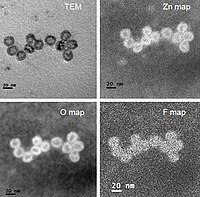
Photo from wikipedia
An inorganic p-type CuInS2 semiconductor was combined with the semiconducting polymer of PNDI3OT-Se1 and PNDI3OT-Se2 with different HOMO/LUMO levels for photoelectrochemical hydrogen production. Charge transfer behaviors at polymer/CuInS2 junctions were… Click to show full abstract
An inorganic p-type CuInS2 semiconductor was combined with the semiconducting polymer of PNDI3OT-Se1 and PNDI3OT-Se2 with different HOMO/LUMO levels for photoelectrochemical hydrogen production. Charge transfer behaviors at polymer/CuInS2 junctions were investigated by electrochemical impedance spectroscopy. The heterojunction of p-CuInS2 and n-type polymer (both PNDI3OT-Se1 and Se2) successfully made p-n junctions and showed improved charge transfer. However, we found that higher HOMO levels of polymer than valence band maximum (VBM) of CuInS2 spurred charge recombination at interfaces. As a result, CuInS2 /PNDI3OT-Se1/TiO2 /Pt, which has suitable energy levels matched between PNDI3OT-Se1 and CuInS2 , shows photocurrent (-15.67 mA cm-2 ) improved concretely when compared to a CuInS2 /TiO2 /Pt photoelectrode (-7.11 mA cm-2 ) at 0.0 V vs. RHE applied potential. Additionally, the photoelectrochemical stability of CuInS2 /PNDI3OT-Se1/TiO2 /Pt photoelectrode was also investigated.
Journal Title: ChemSusChem
Year Published: 2020
Link to full text (if available)
Share on Social Media: Sign Up to like & get
recommendations!